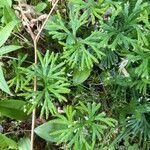Horizontal stems elongate, mostly shallowly subterranean, 1–2 mm thick, with distant, reduced lvs; erect stems to 3 dm, branched, the branches indeterminate, with annual constrictions, the branchlets obviously flattened, 2–3 mm wide (incl. lvs) shiny, bright green or somewhat yellowish-green; lvs 4-ranked, entire, adnate over half their length, the upper appressed, the lateral having a short, deltoid free part with slender, spreading or incurved tip, the lower much reduced, seldom 1 mm long; cones 1–2.5 cm, 3–5 mm wide; without a sterile tip, 1–4+ on forked, remotely bracteate peduncles; sporophylls yellowish, broad-based, with scarious erose margins; sporangia reniform, 1.4–1.7 mm wide; spores as in no. 11 [Lycopodium clavatum L.]; 2n=46. Woods and rocky slopes in acid soil; circumboreal, s. in our range to Pa. and Minn.

